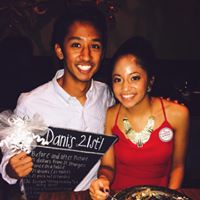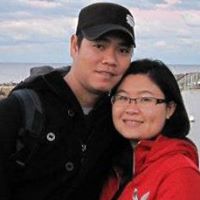Thai N Le
age ~60
from Stockton, CA
- Also known as:
-
- Thai Ngoc Le
- Thanh T Lau
- Thanh T Thai
- Thai Nle
- Ngoc Le Thai
- Le N Thai
- Ngoc Ledong
Thai Le Phones & Addresses
- Stockton, CA
- San Jose, CA
- Oakland, CA
- Springfield, MA
- New Bedford, MA
- San Joaquin, CA
Us Patents
-
Exchange-Coupled Magnetoresistive Sensor With A Coercive Ferrite Layer And An Oxide Underlayer Having A Spinal Lattice Structure
view source -
US Patent:6992866, Jan 31, 2006
-
Filed:Aug 31, 2004
-
Appl. No.:10/931315
-
Inventors:Matthew Joseph Carey - San Jose CA, US
Eric Edward Fullerton - Morgan Hill CA, US
Bruce Alvin Gurney - San Rafael CA, US
Thai Le - San Jose CA, US
Stefan Maat - San Jose CA, US
Philip Milton Rice - San Jose CA, US -
Assignee:Hitachi Global Storage Technologies Netherlands B.V. - Amsterdam
-
International Classification:G11B 5/39
-
US Classification:36032411
-
Abstract:An exchange-coupled magnetic structure includes a ferromagnetic layer, a coercive ferrite layer, such as cobalt-ferrite, for biasing the magnetization of the ferromagnetic layer, and an oxide underlayer, such as cobalt-oxide, in proximity to the coercive ferrite layer. The oxide underlayer has a lattice structure of either rock salt or a spinel and exhibits no magnetic moment at room temperature. The underlayer affects the structure of the coercive ferrite layer and therefore its magnetic properties, providing increased coercivity and enhanced thermal stability. As a result, the coercive ferrite layer is thermally stable at much smaller thicknesses than without the underlayer. The exchange-coupled structure is used in spin valve and magnetic tunnel junction magnetoresistive sensors in read heads of magnetic disk drive systems. Because the coercive ferrite layer can be made as thin as 1 nm while remaining thermally stable, the sensor satisfies the narrow gap requirements of high recording density systems.
-
Stability-Enhancing Underlayer For Exchange-Coupled Magnetic Structures, Magnetoresistive Sensors, And Magnetic Disk Drive Systems
view source -
US Patent:7116532, Oct 3, 2006
-
Filed:Nov 9, 2004
-
Appl. No.:10/985195
-
Inventors:Matthew Joseph Carey - San Jose CA, US
Eric Edward Fullerton - Morgan Hill CA, US
Bruce Alvin Gurney - San Rafael CA, US
Thai Le - San Jose CA, US
Stefan Maat - San Jose CA, US
Philip Milton Rice - San Jose CA, US -
Assignee:Hitachi Global Storage Technologies Netherlands B.V. - Amsterdam
-
International Classification:G11B 5/39
-
US Classification:36032411
-
Abstract:An exchange-coupled magnetic structure includes a ferromagnetic layer, a coercive ferrite layer, such as cobalt-ferrite, for biasing the magnetization of the ferromagnetic layer, and an oxide underlayer, such as cobalt-oxide, in proximity to the coercive ferrite layer. The oxide underlayer has a lattice structure of either rock salt or a spinel and exhibits no magnetic moment at room temperature. The underlayer affects the structure of the coercive ferrite layer and therefore its magnetic properties, providing increased coercivity and enhanced thermal stability. As a result, the coercive ferrite layer is thermally stable at much smaller thicknesses than without the underlayer. The exchange-coupled structure is used in spin valve and magnetic tunnel junction magnetoresistive sensors in read heads of magnetic disk drive systems. Because the coercive ferrite layer can be made as thin as 1 nm while remaining thermally stable, the sensor satisfies the narrow gap requirements of high recording density systems.
-
Stability-Enhancing Underlayer For Exchange-Coupled Magnetic Structures, Magnetoresistive Sensors, And Magnetic Disk Drive Systems
view source -
US Patent:20020154456, Oct 24, 2002
-
Filed:Apr 24, 2001
-
Appl. No.:09/841942
-
Inventors:Matthew Carey - San Jose CA, US
Eric Fullerton - Morgan Hill CA, US
Bruce Gurney - San Rafael CA, US
Thai Le - San Jose CA, US
Stefan Maat - San Jose CA, US
Philip Rice - San Jose CA, US -
International Classification:G11B005/39
-
US Classification:360/324110, 360/324120, 360/324200
-
Abstract:An exchange-coupled magnetic structure includes a ferromagnetic layer, a coercive ferrite layer, such as cobalt-ferrite, for biasing the magnetization of the ferromagnetic layer, and an oxide underlayer, such as cobalt-oxide, in proximity to the coercive ferrite layer. The oxide underlayer has a lattice structure of either rock salt or a spinel and exhibits no magnetic moment at room temperature. The underlayer affects the structure of the coercive ferrite layer and therefore its magnetic properties, providing increased coercivity and enhanced thermal stability. As a result, the coercive ferrite layer is thermally stable at much smaller thicknesses than without the underlayer. The exchange-coupled structure is used in spin valve and magnetic tunnel junction magnetoresistive sensors in read heads of magnetic disk drive systems. Because the coercive ferrite layer can be made as thin as 1 nm while remaining thermally stable, the sensor satisfies the narrow gap requirements of high recording density systems.
-
Stability-Enhancing Underlayer For Exchange-Coupled Magnetic Structures, Magnetoresistive Sensors, And Magnetic Disk Drive Systems
view source -
US Patent:20050036244, Feb 17, 2005
-
Filed:Sep 27, 2004
-
Appl. No.:10/951397
-
Inventors:Matthew Carey - San Jose CA, US
Eric Fullerton - Morgan Hill CA, US
Bruce Gurney - San Rafael CA, US
Thai Le - San Jose CA, US
Stefan Maat - San Jose CA, US
Philip Rice - San Jose CA, US -
International Classification:G11B005/127
G11B005/33 -
US Classification:360324120
-
Abstract:An exchange-coupled magnetic structure includes a ferromagnetic layer, a coercive ferrite layer, such as cobalt-ferrite, for biasing the magnetization of the ferromagnetic layer, and an oxide underlayer, such as cobalt-oxide, in proximity to the coercive ferrite layer. The oxide underlayer has a lattice structure of either rock salt or a spinel and exhibits no magnetic moment at room temperature. The underlayer affects the structure of the coercive ferrite layer and therefore its magnetic properties, providing increased coercivity and enhanced thermal stability. As a result, the coercive ferrite layer is thermally stable at much smaller thicknesses than without the underlayer. The exchange-coupled structure is used in spin valve and magnetic tunnel junction magnetoresistive sensors in read heads of magnetic disk drive systems. Because the coercive ferrite layer can be made as thin as 1 nm while remaining thermally stable, the sensor satisfies the narrow gap requirements of high recording density systems.
Resumes

Bay Leader
view sourceLocation:
Stockton, CA
Industry:
Chemicals
Work:
Blue Beacon Truck Wash 2011 - 2013
Bay Leader
Bay Leader

Tax Specialist
view sourceLocation:
San Jose, CA
Industry:
Accounting
Work:
Security Industry Specialists, Inc. May 2011 - Dec 2011
Security
Dnn Tax Services May 2011 - Dec 2011
Tax Specialist
Security
Dnn Tax Services May 2011 - Dec 2011
Tax Specialist
Skills:
Security
Police
Tax Preparation
Police
Tax Preparation

Chief Creative Officer
view sourceLocation:
San Francisco, CA
Industry:
International Trade And Development
Work:
Foxean Unity Solutions
Chief Creative Officer
Chief Creative Officer

Thai Le
view source
Thai Le
view source
Thai Le
view source
Thai Le
view source
Thai Le
view sourceLawyers & Attorneys

Thai Q Le, San Francisco CA - Lawyer
view sourceAddress:
Bingham McCutchen LLP
3 Embarcadero Ctr, San Francisco, CA 94111
4153932680 (Office), 4153932286 (Fax)
3 Embarcadero Ctr, San Francisco, CA 94111
4153932680 (Office), 4153932286 (Fax)
Licenses:
California - Active 2009
Education:
Bucerius Law School, Hamburg, Germany
Graduated - 2009
University of California, Hastings College of The Law
Degree - J.D.
Graduated - 2009
Chapman University
Degree - B.S.
Graduated - 2005
University of California - Los Angeles
Graduated - 2002
Graduated - 2009
University of California, Hastings College of The Law
Degree - J.D.
Graduated - 2009
Chapman University
Degree - B.S.
Graduated - 2005
University of California - Los Angeles
Graduated - 2002
Specialties:
Patent Application - 20%
Intellectual Property - 20%
Trademark Infringement - 20%
Copyright Application - 20%
Antitrust / Trade Law - 20%
Intellectual Property - 20%
Trademark Infringement - 20%
Copyright Application - 20%
Antitrust / Trade Law - 20%
Classmates

Thai le
view sourceSchools:
Sunnyside Elementary School Garden Grove CA 1988-1992
Community:
Cathy Conger, Debbie Taft, Kevin Stearns, Dawn Sullivan, Jaydean Eakin, Steve Chapman

Thai Le
view sourceSchools:
Desert View Elementary School Phoenix AZ 1975-1977, Manzanita Elementary School Phoenix AZ 1977-1979
Community:
Sheana Director

Thai Le
view sourceSchools:
Mark Twain Elementary School Federal Way WA 1998-2002
Community:
Debbie Berg, Sherry Baker, Heather Garrett, Michael Bersch, Jason Edwards

Thai Le
view sourceSchools:
Schenck Elementary School Denver CO 1984-1987, Schilling Elementary School Salina KS 1987-1987, Johnson Elementary School Denver CO 1988-1990, Goddard Middle School Littleton CO 1990-1991, Euclid Middle School Littleton CO 1991-1993
Community:
Steven Santiago, Aaron Bliss, James Yoo, Tim Jones, Matt Jennings, Austin Smith, Chrissy Wagner, Nicola Campos

Thai Le
view sourceSchools:
Frelinghuysen Middle School Morristown NJ 1981-1981
Community:
Bob Chase, Jan Rogers, Paul Fleet

Thong Thai Le | La Quinta...
view source
Thai le, Westbury High Sc...
view source
le Thai, Lawrence High Sc...
view sourceYoutube
Flickr
Plaxo

Mr. Le Ngoc Thai Duong
view sourceHue City, CENTRAL VIETNAMSales&Contracting Manager at HUONG GIANG HOTEL RES... GENTLEMAN

mr duong ngoc thai le
view sourcehuong giang tourist jsc

Thai Le
view sourceCreditwatch

Thai le Van
view source
Tyler Thai Le
view source
Thai Nguyen Le
view source
Thai Hoa Le
view source
Thai Le Quoc
view source
Thai le Na
view source
Thai Nhan Le
view source
Thai Binh Le
view sourceMyspace
Googleplus

Thai Le
Work:
Synergixx - Sales Rep (2009-2010)
Education:
Rowan University - Finance
Relationship:
Single
About:
I'm in a band http://www.facebook.com/class6...

Thai Le
Education:
KTS - XD
Tagline:
Là kiến trúc sư chuyên chém gió

Thai Le
Work:
CSL Behring - Process Engineer (2011)
Education:
University of Florida - Computer Software Engineering

Thai Le
Work:
Duoc cuu long
Education:
Nguyen van cu, Dai hoc y duoc TPHCM

Thai Le
Work:
Huyện Vũ Thư - Thái Bình
Education:
ĐH PCCC - T34
About:
Lê Văn Thái SN: 1985 QQ: Thái Bình

Thai Le
Work:
VICE - Web Developer

Thai Le
Work:
Dai hoc tran dai nghia

Thai Le
Work:
Ban Quan Ly Du an
Get Report for Thai N Le from Stockton, CA, age ~60














